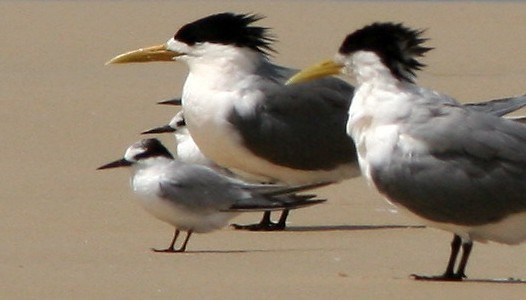Little Tern
A species of Small terns Scientific name : Sternula albifrons Genus : Small terns
Little Tern, A species of Small terns
Botanical name: Sternula albifrons
Genus: Small terns
Content
Description General Info
 Photo By Jimfbleak , used under CC-BY-SA-2.5 /Cropped and compressed from original
Photo By Jimfbleak , used under CC-BY-SA-2.5 /Cropped and compressed from original Description
The little tern (Sternula albifrons) is a seabird of the family Laridae. It was formerly placed into the genus Sterna, which now is restricted to the large white terns. The genus name is a diminutive of Sterna, "tern". The specific albifrons is from Latin albus, "white", and "frons", forehead. The former North American (S. a. antillarum) and Red Sea S. a. saundersi subspecies are now considered to be separate species, the least tern (Sternula antillarum) and Saunders's tern (Sternula saundersi). This bird breeds on the coasts and inland waterways of temperate and tropical Europe and Asia. It is strongly migratory, wintering in the subtropical and tropical oceans as far south as South Africa and Australia. There are three subspecies, the nominate albifrons occurring in Europe to North Africa and western Asia; guineae of western and central Africa; and sinensis of East Asia (SE Russia to Japan, SE Asia, Philippines) and the north and east coasts of Australia and New Guinea The little tern breeds in colonies on gravel or shingle coasts and islands. It lays two to four eggs on the ground. Like all white terns, it is defensive of its nest and young and will attack intruders. Like most other white terns, the little tern feeds by plunge-diving for fish, usually from saline environments. The offering of fish by the male to the female is part of the courtship display. This is a small tern, 21–25 cm long with a 41–47 cm wingspan. It is not likely to be confused with other species, apart from fairy tern and Saunders's tern, because of its size and white forehead in breeding plumage. Its thin sharp bill is yellow with a black tip and its legs are also yellow. In winter, the forehead is more extensively white, the bill is black and the legs duller. The call is a loud and distinctive creaking noise. The little tern was described by the German naturalist Peter Simon Pallas in 1764 and given the binomial name Sterna albifrons. 
Size
28 cm
Life Expectancy
21 years
Nest Placement
Ground
Feeding Habits
Little Tern primarily consumes small fish, crustaceans, insects, annelids, and molluscs. It exhibits dive hunting techniques for prey capture, often feeding at twilight. Little Tern shows a preference for shallow coastal waters, reflecting unique dietary adaptations to its habitat.
Habitat
The little Tern occupies subtropical to temperate zones, from coastal regions to inland waterways and altitudes up to 2000m. Key habitats encompass sparsely vegetated shorelines, estuary spits, and inland waterbodies. During non-breeding seasons, they frequent tidal zones and venture into open sea. Habitat preference shifts toward areas with minimal disturbance, such as inland lake shores, due to environmental pressures.
Dite type
Piscivorous
General Info
Feeding Habits
Bird food type
Species Status
Not globally threatened.